|
Cannock Road to Fox's Lane 2 This section
of the canal stretches from lock 6 to lock 10 and
includes Griffin, Morris, & Griffin's Ceres Works,
and the Corporation's Team Department.
Ceres Works -
Griffin, Morris, & Griffin
The company was founded by
Edward Griffin in 1821 on Snow Hill, importing hemp,
flax, and tar. He manufactured nets, rope, and
twine, and sold boat cloths, door mats, mill sails,
sacks, tarpaulins, and wagon and cart covers.
His entry in Pigot & Company’s
1842 Staffordshire directory is as follows:
Edward Griffin, rope, rick
cloth, and sacking. Baltic Place, Snow Hill.
He was joined by John Morris in
the 1840s, and formed Griffin & Morris and Company. |
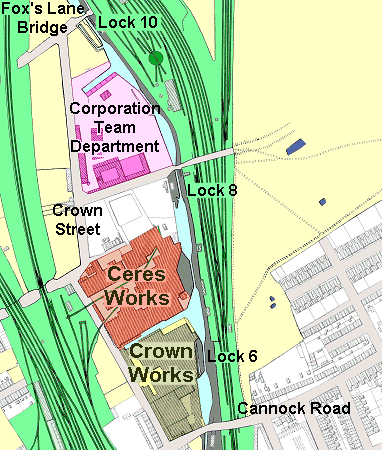 |
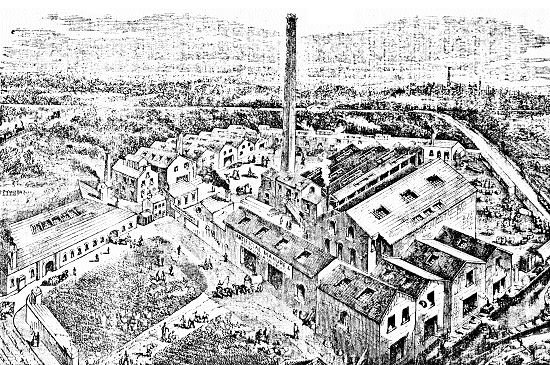 |
Ceres Works, from the
London & North Western Railway's guide book of 1861.
The company's canal basin and
wharves are in the bottom right-hand corner. |
|
The company’s entry in White’s
1851 Staffordshire directory is as follows:
Griffin & Morris and Company,
rope, twine, and sacking manufacturers, and linseed
cake dealers, Snow Hill.
By 1857 the business had moved
to Ceres Works and began to manufacture manure. On
Sunday 22nd November, 1857 a large fire engulfed the
Snow Hill site, which the company vacated. An
article about the fire, published in the
Wolverhampton Chronicle on Wednesday 25th November,
1857 states that the business moved from the Snow
Hill premises to the company's other premises off
Stafford Road, where they made manure. So at that
time Ceres works was already in operation.
Their entry in the 1860 Post Office Directory lists
them as manure merchants and agents.
The works had two covered
wharves above a large basin at the southern end of
the site, and a number of loading bays along the
side of the canal.
By this time the company’s name
had changed to Griffin, Morris, & Griffin.
|

John Morris. |
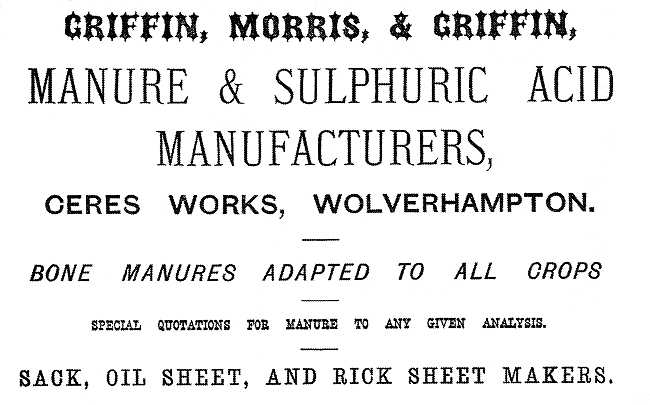
| Another view
of Ceres Works. |
|
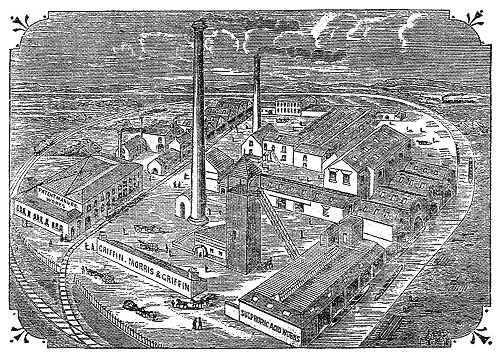 |
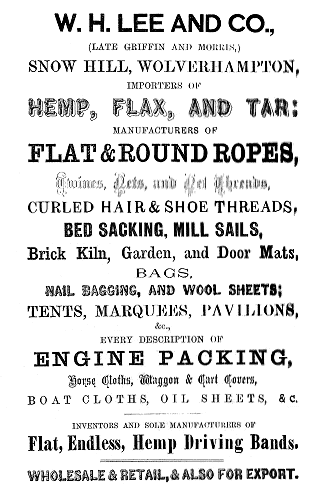 |
This advert from an 1861
trade directory shows that the business on Snow Hill
had been sold to
W. H. Lee & Company, and continued to sell a similar
range of products. |
|
The 1861 North Western Railway
Guide includes a description of the company and the
production of artificial manures. The sections that
relate to Ceres Works are as follows:
…having run with the train
through Wolverhampton station, you have only to look
down the embankment on your right hand, to discover
an extensive pile of bright red brick buildings;
which constitute the Ceres Works of Messrs. Griffin,
Morris, and Griffin, and are the most complete and
flourishing artificial manure works to be found in
the United Kingdom.
The buildings are somewhat
striking in appearance, and, being built of bright
red bricks, contrast favourably with the many
smoke-stained and dingy erections which have been
passed. The area of the works is about 4 acres, and
they are so located as to command the best means of
transit to every part of the kingdom, the Birmingham
and Liverpool Canal constituting their boundary on
one side, and the London and North Western and the
Shrewsbury and Birmingham railways being in almost
immediate contiguity on the other – presenting
facilities of conveyance that are of the highest
importance in the case of a manufacture which is at
once of considerable bulk and weight, and in which
economy in the cost of transit (of both the raw
material and the completed article) becomes no
inconsiderable element of the price……
……it is the province of
agricultural chemistry, in connection with
accelerated conversion, as evidenced at the “Ceres
Works” of Messrs. Griffin, Morris, and Griffin, to
supply. The principal material in all artificial
manures is bones, but subsidiary articles, such as
dried horse flesh from South America, and dried ox
blood, gathered chiefly on the continent, are also
constituents, and contribute, with the necessary
admixtures, to the formation of the various manures
– not less than 10 distinct kinds, which are found
to be the most suitable to different crops; thus,
some for wheat and straw crops, and some for green
crops; some for root crops.
In the
manufactory of Messrs. Griffin, Morris, and Griffin,
thousands of tons of bones are – we were about to
say, annually consumed – but we must say, rendered
the means of producing thousands of tons of food –
grain and grass alike benefiting by their
application in the shape of artificial manure.....
....It
would be quite impossible to enumerate the various
processes these bones undergo before they are
finally ready for the dissolving machine; suffice it
to say, that the various mills and machinery,
requiring steam power equal to 70 horse, are of the
most perfect and complete character: and the
surprise to us, was that a manufacture of so
comparatively a modern date should have so soon
attained such perfection.....
....The
substances come forth in a semi-liquid state; they
are then carried off to different deposits according
to their kind, the machine that we have noticed
turning out between 70 and 80 tons daily. The manure
for this has become its designation, is placed under
shelter in vast heaps, rising with pathway round,
except that they are square, like pyramids, until
they are 40 or 50 feet high. In this state they dry
and become solid. When wanted, they are broken up,
and often from 30 to 40 men are employed in breaking
up a single heap. It is riddled as it is broken up
in large circular riddles – the larger pieces that
will not pass through the riddle being carried off
to the respective places allotted for its reception,
and bagged for transmission to its destination.....
....We
must however stop, but we cannot do so without
noticing that, owing to the large expenditure they
have incurred, and the scientific means to which
Messrs. Griffin, Morris, and Griffin have resorted,
the manufacture is carried on without emission of
effluvia offensive to the neighbourhood: they are,
by mechanical and chemical appliances which we
cannot describe, completely destroyed. The demand
for artificial manures is great, and it is every day
increasing. Messrs. Griffin, Morris, and Griffin
are, we believe, among the largest manufacturers;
and we cannot better close our notice than by
recommending all who take an interest in one of the
most important manufactures of modern times, to pay
a visit to their establishment. We may add that a
large sack, sack cloth, and tarpaulin manufactory is
attached, which has been established nearly 40
years, and is one of the most extensive in England.
|
| In June 1861 the following article about Ceres
Works appeared in the second edition of 'The
Official Illustrated Guide to the Great Western
Railway': |
|
The first object that
strikes the eye on entering the gateway of
the 'Ceres Works' is a yard full of refuse
woollen textures; this is a reserve stock,
as a guard against contingencies in
reference to supply. The next object in
order is an immense collection of bones, raw
boiled, and calcined. The former are
collected in neighbouring towns and
counties, and subjected to the influence of
heat for the extraction of those gelatinous
and oily matters which would otherwise
retard the dissolution of the whole organic
construction. This heating is more
economical in point of time and agents, than
the application of sulphuric acid to them in
the raw state would be.
Hoofs and horn parings
lie about in odd corners, but as these
objects are small in proportion to the other
parts of animal structure no further notice
of them need to be taken than to say, it is
a good thing that they are not wasted as
they used to be, but that their valuable
elements, though small, are rendered capable
of at once entering into reproduction, first
of plants, and secondly of animals.
With these things
before us as stock, we have a key to the
local reputation of this firm as manure
manufacturers, and substantial material to
work upon in this current historical
narrative relating to agricultural
progression. Wool has been proved to be a
fertiliser second to no other material for
certain crops, as for instance, by the
favour that woollen rags are in with
hop-growers; and equally so in certain
proportions with other fertilisers, for both
corn and green crops. Bones also are too
well known, from their proved effect on
dairy pastures, and in a boiled form in
large quantities, or as superphosphate in
small quantities for turnips to need any
special recommendation.
The refuse woollen
material is first introduced into the maw of
a 'wool digester'. This is a cylindrical
iron boiler, about ten feet deep by six in
diameter, with a fixed hood on it, having a
door about eighteen inches square on the
side of the hood for its introduction. Then
a given quantity, varying to the
requirements of the hour, has been
introduced, loose 'waste' is placed on the
edges and the door is closed and screwed
down that no offensive effluvia may escape.
A pipe is attached to the top for conveying
the steam and scent to a special condenser
and purifier, at a distant part of the
premises. Sulphuric acid is the agent used
to liquefy this woollen waste, and in a few
minutes that which was wool and sulphuric
acid is ready to be drawn off when required
as sulphate of ammonia. This retort will
hold about two tons of waste, and in from
thirty to forty minutes that quantity can be
liquefied and combined in the proportions as
sulphate of ammonia.
The raw bones are first
placed in a similar boiler, but with a door
at the bottom to rake them out, when
sufficiently acted on, and the 'size' from
them has been drawn off. These bones are not
subjected to great heat, but to a continuous
steam for some hours, till the gelatinous
substance which gave them toughness has been
withdrawn as 'size', and they are in a fit
state to grow brittle as they get dry. These
bones, when fit, and the calcined heaps,
which are always ready, are crushed and
ground to an impalpable powder by French
stone mills, just as wheat is made into
meal. The small proportions of palpable
particles, or the 'offal' as it may be
turned in this milling comparison, is
separated by sieves, and reserved to supply
ten percent of insoluble phosphate of lime
that it is advisable to use in nominally
soluble fertilisers, that too much food may
not be present for the plants at starting,
and, as in the case of turnips, complete
exhaustion by September or October.
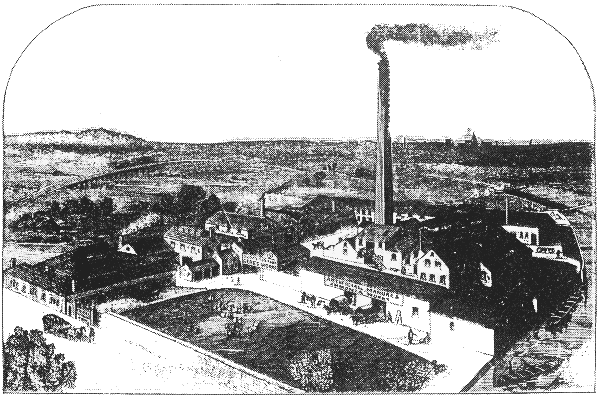
Ceres Works
Running from the bottom
of the 'wool digester' is a cistern, above
which is a trough with a trap board at the
bottom. In this trough a certain quantity of
bone dust is put, when jerk goes a lever,
and down goes that article into the cistern.
A certain quantity of sulphuric acid then
spouts from some subterranean source. All
this time two Archimedean screws are at
work, one, one way, the other opposing, so
that in a few minutes the contents, so far,
are in an agitated mass of bubbles and
paste. Then the tap from the 'wool digester'
is turned on till an exact proportion has
been poured in, by which time the matter of
the cistern is all bubbles and soup, with no
paste. During this time the man at the
trough is still at work, and at the end of a
fixed time jerk goes the lever again, and
down goes that lot into the mixing tank. The
last jerk or two supply drying or shortening
organic material. If this were not
introduced, the dissolved wool, hooves and
horns, and the subtle cohesive qualities of
bones that have been liberated by heat and
sulphuric acid, together with the returned
portion of the gelatinous fluid previously
extracted, on cooling, would turn tough and
hard, and a farmer would be as well pleased
with a ton of gutta percha, in its native
impurity, for distribution.
This is the digesting,
dissolving, and blending process of this new
feature in agriculture for economising
labour, and making fertiliser out of
substances that a few years ago were thrown
to the dogs, and afterwards kicked out of
one's way or pitched into a hole or rut for
the combined purpose of getting rid of this
nuisance, and helping to fill up in some
sort of way. All this is carried on with so
much regularity; every man being at his
lever, tap, bag of material, shovel, truck,
or barrow that from two or three tons of the
mixture, of pease pudding consistency, are
evacuated, and this rapidly by means of the
'eternal' screws, every thirty five minutes!
A clock is before the
foreman at the trough, and his lever and the
taps are directed by him at those stated
intervals which have been found long enough
to be economical, and short enough to admit
of despatch. Messrs Griffin, Morris and
Griffin's success, as artificial manure
manufacturers, is no doubt owing, in a great
measure, to the enormous quantity of
sulphuric acid they use, in their own way,
in developing the raw material they search
for; and also, in their own way, get. The
ponderous heap above mentioned is like good
beer in a good cellar, improving day by day,
to come out with its qualities fully
developed for spring and summer consumption.
In conclusion, we may
mention another branch of business attached
to this artificial manure manufactory, as
there is a preparation being made for
adopting novel features of this wonderful
age for mechanical contrivances, and works
for lessening labour, both of men and women.
The senior partner of this firm established
long ago an extensive tarpaulin and
sack-making business. The reputation of the
present firm has commanded for them so great
a demand for their cloths and sacks, that
they cannot get them made half fast enough
by hand. Consequently they have fixed a
seven horsepower steam engine to drive eight
sewing machines and a printing press for
stamping the names of their customers on
these articles. One sewing machine is being
worked by hand, and no simple handwork can
touch it by comparison. But this is not half
fast enough even for that. What is wanted at
present is machinery that will turn out a
sack, cut from the piece, sewn and printed,
about every half minute or so, and
tarpaulins in proportion. To make the latter
thoroughly waterproof, about a fortnight is
absorbed in dressing and drying, and
redressing and re-drying them. |
|
|
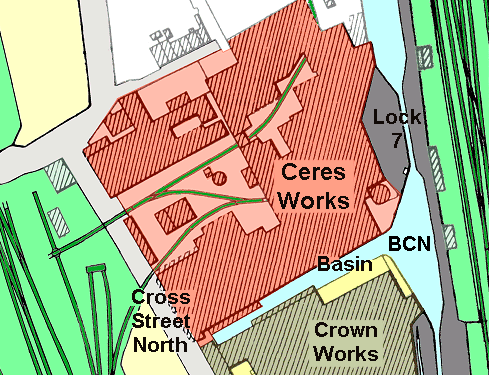
A larger map of the works. |
The company’s products included
artificial manure manures for all crops, growing and
fatting compounds for horses, oxen, cows, and sheep.
Corn, flour and potato sacks, rick cloths and
tarpaulins, wagon and cart sheets, canvas and hair
nose bags and cloths.
On 9th November,
1866 John Morris began his term as mayor of
Wolverhampton.
On Friday 30th November,
Queen Victoria visited the town to unveil the statue
of Prince Albert in Queen Square. During the
ceremony he was knighted by the queen. |
|
In 1871 Edward Griffin retired,
leaving two members of his family to run the
business with John Morris.
The company then became Morris
& Griffin. In the same year they began to
manufacture sulphuric acid.
By 1926 the factory had closed
because in that year the site was purchased by
Wolverhampton Corporation. |
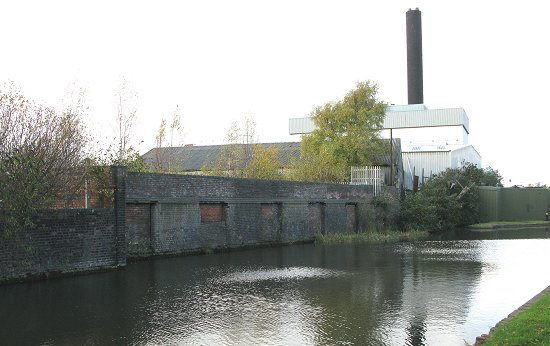
The remains of the loading
bays. |
| Crown Street Wharf and the
Corporation Team Department |
|
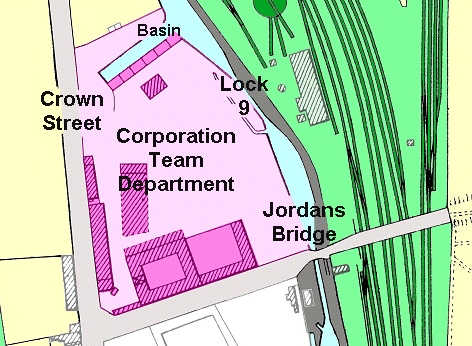
The location of the site. |
Sanitation as we know it today is a relatively
modern thing.
In many towns, sewers were not laid to all of the
houses until well into the 1920's. |
|
The late George Peck who was 99 years old (in
2009) remembered what it was like when the night
soil men used to call:
Our toilet was just a hole in
a wooden board with a metal container below, which
of course had to be emptied and the contents
disposed of. We used to have 2 or 3 toilets to 5 or
6 houses. One board with a hole cut in and a big
galvanised tank with 2 handles, underneath.
They used to come every so
often to empty it. They would come in rough sort of
clothes, rough sort of blokes, they'd come with
their horse and cart. It was just an open cart, you
see, with roll-up waterproof covers. It would carry
about 10 of these things. They would put a big hook
on and drag them across the yard. It was a big yard,
the things used to come over bricks and there was
nothing made on the level, just up and down. They
had got to drag them down the entry. They used to
overspill and it would be all over the floor. Two
men would lift them onto the cart and when it had
got the 10 or 12 vessels in, they used to drive it
through the main street and down to Crown Street,
where they were emptied.
There was a big field there, by
the canal, where they emptied a lot of them.
Naturally it developed a lot of maggots. Blokes
couldn't afford maggots to go fishing and they used
to go there to get them. I went there as a kid, my
dad was with me, so he must have been getting them
as well. We used to go fresh water fishing. That was
something you used to enjoy. On night, one bloke
went the wrong way and fell into the ‘whatsit’, up
to his arms in it. They pulled him out and he stank
terrible, so they said "We can't do nothing with
you" and dragged him, and threw him in the cut. They
got him out and took him home. That was down the
bottom of Crown Street. Of course the Corporation
was in Crown Street, where all of the factories are
now.
The first
water toilet we had was down a kind of a well. It
was about ten feet down and was what they called an
offset tip. It was a cylindrical vessel at the
bottom that was unevenly balanced so that when it
eventually filled up with water, it would tip itself
into a sump, which they had got to empty eventually.
That was our first water toilet. All your ashes and
things used to be thrown into a big hole in the side
of the wall and blokes used to have to come and
shovel them out. The ashes were shovelled into
baskets that they carried across the yard on their
heads, down the entry and were tipped into the ash
cart. The ashes were also taken to Crown Street. You
had to pay them to take them away. Youngsters don't
know what they have missed. |
|
The night soil men were an
essential part of town life until the deep sewers
were laid.
In 1863 the Wolverhampton Manure Company
had the contract for night soil, which was later
passed on to R. Deans & Son.
In 1868 when the
Council took on the responsibility for sewage, under
the control of the ‘Team’ Committee. Deans & Son’s
premises in School Street were purchased for the
operation.
In 1872 the ‘Team’ Committee
purchased a piece of land on the northern side of
Ceres Works from Morris & Griffin at a cost of
£3,000.
The land lay in between the canal and Crown
Street, and extended from Jordans Bridge over the
canal to Fox’s Lane Bridge. |
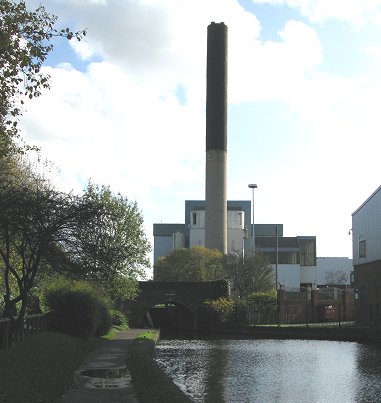
Wolverhampton's Waste
Incinerator. |
|
The Team Committee’s report
describes the site as follows:
During
the year a piece of land (about 6 acres), near the
Ceres Works, has been purchased by the Corporation,
a portion of which is to be used for sanitary
purposes, and the Public Works Committee are about
to construct a canal basin and stabling on it, for
the accommodation of this department. Your committee
expect great benefit from having premises so
convenient, and such improved facilities for getting
rid of night soil, besides which, from its
situation, they will effect a great saving in canal
dues.
The night soil was distributed
to farmers using the Corporation’s own boats.
Eventually the facility became unnecessary as the
old slums disappeared, and sewers were laid. The
site is now occupied by Wolverhampton’s Waste
Incinerator.
|
 |
Return to the Canals
and Industry Menu |
|